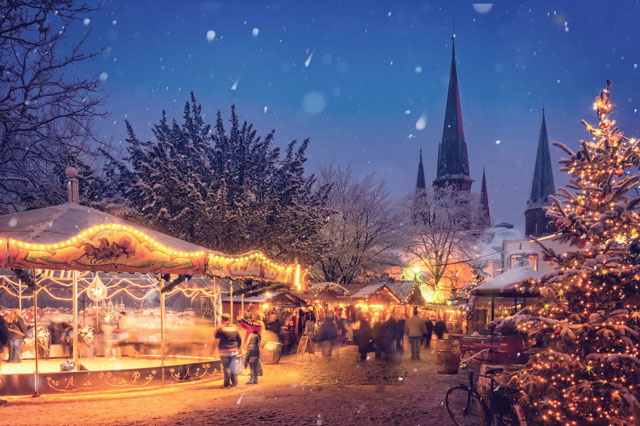When it’s Christmastime in Germany, the town squares transform into enchanted holiday scenes with open-air stalls, decorated Christmas trees, and brightly lit paper stars. Aromas of sizzling sausage, spices, and sweets delight the senses. As soon as Advent begins, the Christmas markets begin to appear, presenting their seasonal foods and traditional handicrafts. German Christmas markets, also known as Weinachtsmarkts or Christkindlmarkts, began hundreds of years ago as winter markets where villagers could purchase necessary items for the long, cold months ahead. As they spread to other German villages, they became more than marketplaces—they evolved into highly anticipated holiday events. Each unique Christmas market provides a distinct experience with holiday themes, regional foods, and custom crafts.
Berlin
Berlin hosts over seventy Christkindlmarkts throughout the city. The largest market has sixty stalls and specializes in regional fare such as dried fruit, bratwurst, and beer. Local choirs perform every evening, contributing to the holiday festivities. The traditional markets present a live nativity or a Christkind (a local girl dressed as an angel). Additional markets feature Scandinavian-themes with toboggans, still others have merry-go-rounds and family-friendly entertainers, and for the romantically inclined, there are markets that offer horse-drawn carriage rides. There is something special for everyone at the Berlin Christkindlmarkts.
Cologne
The Cologne Christmas market is the largest in Germany, featuring 160 stalls to attract the four million visitors each year. The market is held in the town square by the grand Cologne Cathedral and boasts the tallest Christmas tree of Germany’s Christmas markets. The scent of chocolate is in the air with cocoa-dusted truffles and thick, steamy hot chocolate drinks offered from the booths. Cologne’s market is one of the most delightful of all the German Christmas markets.
Dresden
Dresden’s Striezelmarkt is thought to be the oldest German Christmas market. The Striezelmarkt is famous for displaying the world’s largest Weihnachtspyramide (traditional German scenes stacked in a wooden pyramid), as well as the world’s tallest Nüssknacker (nutcracker). An exclusive event of the Dresden market is the Stollen Festival that showcases a very large Stollen (a type of fruitcake). It is carried through the market by local bakers to great fanfare, and then sliced and sold to raise money for local charities. The Dresden market enthusiastically maintains the heritage of Germany’s Weihnactmarkts.
Nuremberg
The legendary Nuremberg Christkindlmarkt is held in Nuremberg’s Hauptmarkt (main square). It retains its traditional charm with 180 red and white roofed stalls that sell only handmade items. While the artisans and crafts are enticing, the food is what makes the market famous. The Gerstacker Glühwein (blueberry mulled wine) is a unique Nuremberg tradition. Visitors come from all over to enjoy the renowned Zwetschgenmännle (people-shaped dried plum treats), as well as the legendary Lebkuchen (a gingerbread-like cookie). The old mail coaches, pulled by Clydesdale horses, transport people over the cobblestone streets of Old Town. It is the best way to experience the fairytale-like atmosphere of the Nuremberg Christmas market.
Stuttgart
The Stuttgart Christmas market is set against the backdrop of the Old Palace, Southern Germany’s oldest castle built in 941 AD. All but the foundation and a few walls were destroyed during World War II air raids. Rebuilt in 1944, the Old Palace is a symbol of resilience and, as such, is a fitting gathering place for the Stuttgart Christmas market. Three hundred stalls decorated with evergreen boughs and lighted paper stars surround a large ice rink set in the Old Palace inner court. Food stalls tempt passers-by with bratwurst, candied nuts, and Schneeballen (snowball-shaped cream-filled pastries). Other stalls display hand-blown glass ornaments, wooden incense smokers, and traditional handmade cuckoo clocks. The historic Stuttgart Christmas market delivers an unforgettable experience in a beautiful location.
German Christmas markets offer a uniquely charming and delightful opportunity to enjoy the holiday. Communities gather to celebrate, lights twinkle on trees and stalls, and chestnuts really are roasted over open fires. Weinachtsmarkts not only create the magic of Christmas—they share it with the world.
— Laurie Weisler

